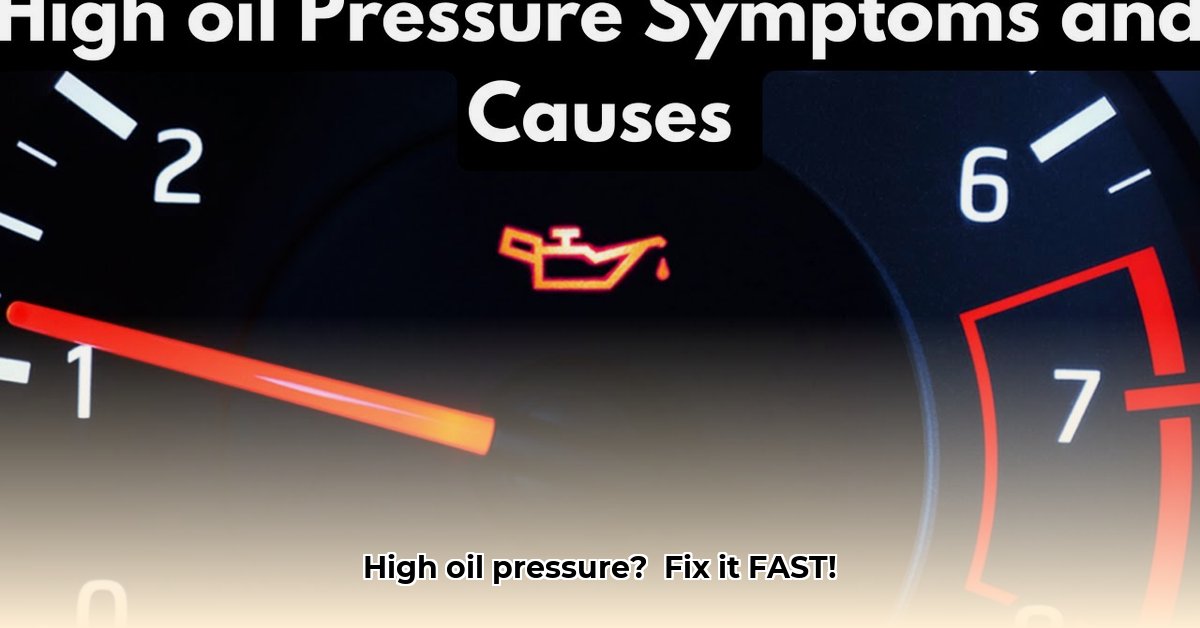High oil pressure in your car signals a potential problem that could lead to significant engine damage. Understanding the causes and addressing them promptly is crucial for maintaining your engine’s health and longevity. Let’s delve into the reasons behind high oil pressure and explore practical solutions.
Understanding High Oil Pressure: Why It Matters for Your Engine
Your car’s oil pressure gauge is a key indicator of your engine’s internal health. A reading that’s consistently higher than normal suggests an issue that, if ignored, can lead to damaged engine bearings, complete engine failure, and costly repairs. Early detection and prompt action are essential. Consider it a critical warning light specifically for your engine’s lubrication system.
The Risks of Neglecting High Oil Pressure
Ignoring high oil pressure can result in:
- Damaged Engine Bearings: These are critical components that ensure smooth engine operation.
- Complete Engine Failure: This often requires extensive and expensive repairs or even engine replacement.
- Costly Repairs: Addressing the issue early can prevent a minor problem from escalating into a major expense.
Common Causes: Identifying the Culprits Behind High Oil Pressure
Several factors can contribute to high oil pressure. Pinpointing the root cause is the first step toward resolving the issue. A careful and methodical diagnosis is important to avoid unnecessary repairs and ensure the right solution is applied.
- Incorrect Oil Viscosity: Using oil that’s too thick (high viscosity) for your engine, especially in cold weather, can increase pressure. Refer to your owner’s manual for the recommended oil type and viscosity grade. Oil viscosity refers to the oil’s resistance to flow at a given temperature.
- Clogged Oil Filter: A restricted or clogged oil filter restricts oil flow, causing a pressure buildup in the system. Regular oil changes with a fresh, high-quality filter are essential for maintaining proper oil flow and engine health.
- Blocked Oil Passages: Over time, sludge and deposits can accumulate inside your engine, narrowing the oil pathways and increasing pressure. This often requires professional attention to clean and restore proper oil flow. Sludge is a thick, dark residue that forms from oxidized oil, combustion byproducts, and contaminants.
- Malfunctioning Pressure Relief Valve: This valve is designed to regulate oil pressure and release excess pressure when it reaches a certain level. If the valve is stuck or malfunctioning, it may not release pressure properly, leading to high oil pressure. A mechanic’s inspection and repair are typically required.
- Worn Oil Pump: In some cases, a worn-out oil pump can pump too much oil, resulting in excessive pressure within the engine.
- Faulty Oil Pressure Sensor: A faulty or inaccurate oil pressure sensor can provide a false reading on the gauge, indicating high oil pressure when the actual pressure is within the normal range.
Diagnosing High Oil Pressure: A Step-by-Step Approach
Before you begin any repairs, it’s crucial to accurately determine the underlying cause of the high oil pressure. If you’re not comfortable working on your car or lack the necessary tools and expertise, it’s best to consult a qualified mechanic.
- Monitor the Oil Pressure Gauge: Observe your oil pressure gauge closely. Is the reading consistently high after the engine reaches its normal operating temperature? Note any fluctuations or patterns in the readings.
- Verify Oil Type and Viscosity: Consult your vehicle’s owner’s manual to ensure you’re using the correct oil type and viscosity grade for your engine and the current climate conditions. Using the wrong oil can significantly affect oil pressure.
- Inspect the Oil Filter: Visually inspect your oil filter for any signs of dirt, damage, or excessive age. A clogged or restricted filter can cause a buildup of pressure in the system.
- Seek Professional Help: If you’re unsure about the diagnosis or lack the necessary expertise, it’s best to consult a qualified mechanic for accurate diagnosis and pressure testing. Mechanics have specialized tools and knowledge to pinpoint the problem.
Key Diagnostic Steps for High Oil Pressure
Following these steps will help you systematically identify the cause of high oil pressure and determine the appropriate course of action.
- Confirm High Pressure Readings: Begin by verifying the oil pressure gauge readings to confirm that the pressure is consistently high.
- Double-Check Oil Specifications: Carefully review the oil type and viscosity recommendations in your vehicle’s owner’s manual.
- Inspect the Oil Filter: Visually examine the oil filter for signs of clogging or damage.
Quick Fixes: Simple Solutions to Try First
While some causes of high oil pressure require professional attention, there are a few simple solutions you can try first. However, always prioritize safety and refer to your owner’s manual for specific instructions and warnings. Incorrect repairs can potentially cause further damage to your engine.
- Oil and Filter Change: If you suspect a dirty or clogged oil filter, perform a fresh oil change using the correct oil type and a new, high-quality filter. This can often resolve the issue if the filter was the culprit.
- Oil Viscosity Adjustment: Double-check that you’re using the correct oil viscosity for your climate and driving conditions. If you’re using a heavier weight oil than recommended, switching to the correct viscosity may alleviate the high oil pressure.
Preventative Maintenance: Proactive Steps for Pressure Control
Preventing high oil pressure involves consistent monitoring and a proactive approach to regular maintenance.
- Adhere to Recommended Oil Change Intervals: Follow the oil change intervals specified by your car manufacturer in your owner’s manual. Regular oil changes prevent sludge buildup and ensure proper lubrication.
- Utilize High-Quality Oil Filters: Always use a high-quality oil filter every time you change your oil. Quality filters effectively remove contaminants and protect your engine from wear and damage.
- Address Oil Leaks Promptly: Repair any oil leaks promptly, even if they seem minor. Leaks can lead to low oil levels, which can indirectly affect oil pressure and engine performance.
The Financial Benefits of Preventative Maintenance
Preventative maintenance is a cost-effective strategy for maintaining your car’s health and preventing expensive repairs down the road.
- Prevents Sludge Buildup: Regular oil changes prevent the accumulation of sludge and deposits, ensuring proper oil flow and lubrication.
- Protects Against Contaminants: Quality oil filters protect your engine from harmful contaminants that can cause wear and damage.
- Reduces the Risk of Major Repairs: Proactive maintenance minimizes the risk of major engine problems and costly repairs.
Risk Assessment: Understanding the Severity of Different Causes
Assessing the risk level associated with different causes of high oil pressure helps you understand the potential consequences and prioritize appropriate action.
| Component | Risk Level | Potential Consequences | Mitigation |
|---|---|---|---|
| Clogged Oil Filter | Medium | Reduced lubrication, engine overheating, potential damage | Regular oil changes with high-quality filters |
| Blocked Oil Passages | High | Significant engine damage, potential failure | Professional cleaning or repair |
| Faulty Relief Valve | High | Catastrophic engine damage | Professional repair or replacement |
| Incorrect Oil Viscosity | Medium | Increased wear and tear, reduced engine efficiency | Using the manufacturer’s recommended oil viscosity |
| Worn Oil Pump | High | Insufficient lubrication, engine seizure | Professional diagnosis and potential replacement |
| Faulty Oil Pressure Sensor | Low to Medium | Inaccurate gauge readings, potential misdiagnosis | Professional diagnosis and sensor replacement |
By understanding the potential causes of high oil pressure, adhering to routine maintenance schedules, and seeking professional assistance when necessary, you can significantly reduce the risk of major engine damage and keep your vehicle running smoothly. High oil pressure is a serious issue that should not be ignored.
Diagnosing High Oil Pressure in Different Engine Types
Diagnosing high oil pressure often requires a systematic and methodical approach. While the fundamental principles remain the same, certain engine types may necessitate specific diagnostic techniques. Modern engines often rely on sophisticated electronic control systems and may require the use of diagnostic scanners for accurate troubleshooting.
Key Takeaways:
- High oil pressure, although less common than low oil pressure, is a serious issue that can lead to significant engine damage.
- Early detection is essential for preventing costly repairs and maintaining engine health.
- Several factors can contribute to high oil pressure, ranging from simple fixes to complex engine issues.
- Professional help is recommended if you’re unsure about how to proceed or lack the necessary expertise.
Identifying the Symptoms of High Oil Pressure
High oil pressure may not always manifest obvious symptoms, but there are several indicators to watch out for. These include an oil pressure gauge reading that’s consistently higher than usual, unusual engine noises such as persistent ticking or knocking, and oil leaks.
A Step-by-Step Guide to Diagnosing High Oil Pressure
Diagnosing high oil pressure requires a systematic approach that involves careful observation, inspection, and potentially specialized tools.
- Monitor the Oil Pressure Gauge: Carefully observe the oil pressure gauge reading. Readings that consistently exceed the recommended range indicate a potential problem.
- Inspect the Oil Filter: Examine the oil filter for signs of clogging or restriction. A clogged filter can impede oil flow and lead to high oil pressure.
- Verify the Oil Viscosity: Ensure that you’re using the correct oil viscosity grade as specified in your vehicle’s
- Doctor Work Life Balance: Proven Strategies for Physician Well-being - November 20, 2025
- Find Your Work-Life Harmony: Quotes for a Fulfilling Life - November 18, 2025
- CRNA Work-Life Balance: Strategies for a Healthier Lifestyle - November 16, 2025














